- Home
- Edgar Allan Poe
The Narrative of Arthur Gordon Pym of Nantucket Page 15
The Narrative of Arthur Gordon Pym of Nantucket Read online
Page 15
CHAPTER XVI
It had been Captain Guy’s original intention, after satisfying himself about the Auroras, to proceed through the Strait of Magellan, and up along the western coast of Patagonia; but information received at Tristan d’Acunha induced him to steer to the southward, in the hope of falling in with some small islands said to lie about the parallel of 60 degrees S., longitude 41 degrees 20' W. In the event of his not discovering these lands, he designed, should the season prove favourable, to push on toward the pole. Accordingly, on the twelfth of December, we made sail in that direction. On the eighteenth we found ourselves about the station indicated by Glass, and cruised for three days in that neighborhood without finding any traces of the islands he had mentioned. On the twenty-first, the weather being unusually pleasant, we again made sail to the southward, with the resolution of penetrating in that course as far as possible. Before entering upon this portion of my narrative, it may be as well, for the information of those readers who have paid little attention to the progress of discovery in these regions, to give some brief account of the very few attempts at reaching the southern pole which have hitherto been made.
That of Captain Cook was the first of which we have any distinct account. In 1772 he sailed to the south in the Resolution, accompanied by Lieutenant Furneaux in the Adventure. In December he found himself as far as the fifty-eighth parallel of south latitude, and in longitude 26 degrees 57' E. Here he met with narrow fields of ice, about eight or ten inches thick, and running northwest and southeast. This ice was in large cakes, and usually it was packed so closely that the vessel had great difficulty in forcing a passage. At this period Captain Cook supposed, from the vast number of birds to be seen, and from other indications, that he was in the near vicinity of land. He kept on to the southward, the weather being exceedingly cold, until he reached the sixty-fourth parallel, in longitude 38 degrees 14' E. Here he had mild weather, with gentle breezes, for five days, the thermometer being at thirty-six. In January 1773, the vessels crossed the Antarctic circle, but did not succeed in penetrating much farther; for upon reaching latitude 67 degrees 15' they found all farther progress impeded by an immense body of ice, extending all along the southern horizon as far as the eye could reach. This ice was of every variety—and some large floes of it, miles in extent, formed a compact mass, rising eighteen or twenty feet above the water. It being late in the season, and no hope entertained of rounding these obstructions, Captain Cook now reluctantly turned to the northward.
In the November following he renewed his search in the Antarctic. In latitude 59 degrees 40' he met with a strong current setting to the southward. In December, when the vessels were in latitude 67 degrees 31', longitude 142 degrees 54' W., the cold was excessive, with heavy gales and fog. Here also birds were abundant; the albatross, the penguin, and the peterel especially. In latitude 70 degrees 23' some large islands of ice were encountered, and shortly afterward the clouds to the southward were observed to be of a snowy whiteness, indicating the vicinity of field ice. In latitude 71 degrees 10', longitude 106 degrees 54' W., the navigators were stopped, as before, by an immense frozen expanse, which filled the whole area of the southern horizon. The northern edge of this expanse was ragged and broken, so firmly wedged together as to be utterly impassible, and extending about a mile to the southward. Behind it the frozen surface was comparatively smooth for some distance, until terminated in the extreme background by gigantic ranges of ice mountains, the one towering above the other. Captain Cook concluded that this vast field reached the southern pole or was joined to a continent. Mr. J. N. Reynolds, whose great exertions and perseverance have at length succeeded in getting set on foot a national expedition, partly for the purpose of exploring these regions, thus speaks of the attempt of the Resolution: “We are not surprised that Captain Cook was unable to go beyond 71 degrees 10', but we are astonished that he did attain that point on the meridian of 106 degrees 54' west longitude. Palmer’s Land lies south of the Shetland, latitude sixty-four degrees, and tends to the southward and westward farther than any navigator has yet penetrated. Cook was standing for this land when his progress was arrested by the ice; which, we apprehend, must always be the case in that point, and so early in the season as the sixth of January—and we should not be surprised if a portion of the icy mountains described was attached to the main body of Palmer’s Land, or to some other portions of land lying farther to the southward and westward.”
In 1803, Captains Kreutzenstern and Lisiausky were dispatched by Alexander of Russia for the purpose of circumnavigating the globe. In endeavouring to get south, they made no farther than 59 degrees 58', in longitude 70 degrees 15' W. They here met with strong currents setting eastwardly. Whales were abundant, but they saw no ice. In regard to this voyage, Mr. Reynolds observes that, if Kreutzenstern had arrived where he did earlier in the season, he must have encountered ice—it was March when he reached the latitude specified. The winds, prevailing, as they do, from the southward and westward, had carried the floes, aided by currents, into that icy region bounded on the north by Georgia, east by Sandwich Land and the South Orkneys, and west by the South Shetland islands.
In 1822, Captain James Weddell, of the British navy, with two very small vessels, penetrated farther to the south than any previous navigator, and this, too, without encountering extraordinary difficulties. He states that although he was frequently hemmed in by ice before reaching the seventy-second parallel, yet, upon attaining it, not a particle was to be discovered, and that, upon arriving at the latitude of 74 degrees 15', no fields, and only three islands of ice were visible. It is somewhat remarkable that, although vast flocks of birds were seen, and other usual indications of land, and although, south of the Shetlands, unknown coasts were observed from the masthead tending southwardly, Weddell discourages the idea of land existing in the polar regions of the south.
On the 11th of January 1823, Captain Benjamin Morrell, of the American schooner Wasp, sailed from Kerguelen’s Land with a view of penetrating as far south as possible. On the first of February he found himself in latitude 64 degrees 52' S., longitude 118 degrees 27' E. The following passage is extracted from his journal of that date. “The wind soon freshened to an eleven-knot breeze, and we embraced this opportunity of making to the west; being however convinced that the farther we went south beyond latitude sixty-four degrees, the less ice was to be apprehended, we steered a little to the southward, until we crossed the Antarctic circle, and were in latitude 69 degrees 15' E. In this latitude there was no field ice, and very few ice islands in sight.”
Under the date of March fourteenth I find also this entry. “The sea was now entirely free of field ice, and there were not more than a dozen ice islands in sight. At the same time the temperature of the air and water was at least thirteen degrees higher (more mild) than we had ever found it between the parallels of sixty and sixty-two south. We were now in latitude 70 degrees 14' S., and the temperature of the air was forty-seven, and that of the water forty-four. In this situation I found the variation to be 14 degrees 27' easterly, per azimuth … I have several times passed within the Antarctic circle, on different meridians, and have uniformly found the temperature, both of the air and the water, to become more and more mild the farther I advanced beyond the sixty-fifth degree of south latitude, and that the variation decreases in the same proportion. While north of this latitude, say between sixty and sixty-five south, we frequently had great difficulty in finding a passage for the vessel between the immense and almost innumerable ice islands, some of which were from one to two miles in circumference, and more than five hundred feet above the surface of the water.”
Being nearly destitute of fuel and water, and without proper instruments, it being also late in the season, Captain Morrell was now obliged to put back, without attempting any further progress to the westward, although an entirely open sea lay before him. He expresses the opinion that, had not these overruling considerations obliged him to retreat, he could have penetrated, if n
ot to the pole itself, at least to the eighty-fifth parallel. I have given his ideas respecting these matters somewhat at length, that the reader may have an opportunity of seeing how far they were borne out by my own subsequent experience.
In 1831, Captain Briscoe, in the employ of the Messieurs Enderby, whale-ship owners of London, sailed in the brig Lively for the South Seas, accompanied by the cutter Tula. On the twenty-eighth of February, being in latitude 66 degrees 30' S., longitude 47 degrees 31' E., he descried land, and “clearly discovered through the snow the black peaks of a range of mountains running E. S. E.” He remained in this neighbourhood during the whole of the following month, but was unable to approach the coast nearer than within ten leagues, owing to the boisterous state of the weather. Finding it impossible to make further discovery during this season, he returned northward to winter in Van Diemen’s Land.
In the beginning of 1832 he again proceeded southwardly, and on the fourth of February was seen to the southeast in latitude 67 degrees 15', longitude 69 degrees 29' W. This was soon found to be an island near the headland of the country he had first discovered. On the twenty-first of the month he succeeded in landing on the latter, and took possession of it in the name of William IV, calling it Adelaide’s Island, in honour of the English queen. These particulars being made known to the Royal Geographical Society of London, the conclusion was drawn by that body “that there is a continuous tract of land extending from 47 degrees 30' E. to 69 degrees 29' W. longitude, running the parallel of from sixty-six to sixty-seven degrees south latitude.” In respect to this conclusion Mr. Reynolds observes: “In the correctness of it we by no means concur; nor do the discoveries of Briscoe warrant any such indifference. It was within these limits that Weddell proceeded south on a meridian to the east of Georgia, Sandwich Land, and the South Orkney and Shetland islands.” My own experience will be found to testify most directly to the falsity of the conclusion arrived at by the society.
These are the principal attempts which have been made at penetrating to a high southern latitude, and it will now be seen that there remained, previous to the voyage of the Jane, nearly three hundred degrees of longitude in which the Antarctic circle had not been crossed at all. Of course a wide field lay before us for discovery, and it was with feelings of most intense interest that I heard Captain Guy express his resolution of pushing boldly to the southward.
CHAPTER XVII
We kept our course southwardly for four days after giving up the search for Glass’s islands, without meeting with any ice at all. On the twenty-sixth, at noon, we were in latitude 63 degrees 23' S., longitude 41 degrees 25' W. We now saw several large ice islands, and a floe of field ice, not, however, of any great extent. The winds generally blew from the southeast, or the northeast, but were very light. Whenever we had a westerly wind, which was seldom, it was invariably attended with a rain squall. Every day we had more or less snow. The thermometer, on the twenty-seventh, stood at thirty-five.
January 1, 1828. This day we found ourselves completely hemmed in by the ice, and our prospects looked cheerless indeed. A strong gale blew, during the whole forenoon, from the northeast, and drove large cakes of the drift against the rudder and counter with such violence that we all trembled for the consequences. Toward evening, the gale still blowing with fury, a large field in front separated, and we were enabled, by carrying a press of sail, to force a passage through the smaller flakes into some open water beyond. As we approached this space we took in sail by degrees, and having at length got clear, lay- to under a single reefed foresail.
January 2. We had now tolerably pleasant weather. At noon we found ourselves in latitude 69 degrees 10' S., longitude 42 degrees 20' W., having crossed the Antarctic circle. Very little ice was to be seen to the southward, although large fields of it lay behind us. This day we rigged some sounding gear, using a large iron pot capable of holding twenty gallons, and a line of two hundred fathoms. We found the current setting to the north, about a quarter of a mile per hour. The temperature of the air was now about thirty-three. Here we found the variation to be 14 degrees 28' easterly, per azimuth.
January 5. We had still held on to the southward without any very great impediments. On this morning, however, being in latitude 73 degrees 15' E., longitude 42 degrees 10' W., we were again brought to a stand by an immense expanse of firm ice. We saw, nevertheless, much open water to the southward, and felt no doubt of being able to reach it eventually. Standing to the eastward along the edge of the floe, we at length came to a passage of about a mile in width, through which we warped our way by sundown. The sea in which we now were was thickly covered with ice islands, but had no field ice, and we pushed on boldly as before. The cold did not seem to increase, although we had snow very frequently, and now and then hail squalls of great violence. Immense flocks of the albatross flew over the schooner this day, going from southeast to northwest.
January 7. The sea still remained pretty well open, so that we had no difficulty in holding on our course. To the westward we saw some icebergs of incredible size, and in the afternoon passed very near one whose summit could not have been less than four hundred fathoms from the surface of the ocean. Its girth was probably, at the base, three-quarters of a league, and several streams of water were running from crevices in its sides. We remained in sight of this island two days, and then only lost it in a fog.
January 10. Early this morning we had the misfortune to lose a man overboard. He was an American named Peter Vredenburgh, a native of New York, and was one of the most valuable hands on board the schooner. In going over the bows his foot slipped, and he fell between two cakes of ice, never rising again. At noon of this day we were in latitude 78 degrees 30', longitude 40 degrees 15' W. The cold was now excessive, and we had hail squalls continually from the northward and eastward. In this direction also we saw several more immense icebergs, and the whole horizon to the eastward appeared to be blocked up with field ice, rising in tiers, one mass above the other. Some driftwood floated by during the evening, and a great quantity of birds flew over, among which were nellies, peterels, albatrosses, and a large bird of a brilliant blue plumage. The variation here, per azimuth, was less than it had been previously to our passing the Antarctic circle.
January 12. Our passage to the south again looked doubtful, as nothing was to be seen in the direction of the pole but one apparently limitless floe, backed by absolute mountains of ragged ice, one precipice of which arose frowningly above the other. We stood to the westward until the fourteenth, in the hope of finding an entrance.
January 14. This morning we reached the western extremity of the field which had impeded us, and, weathering it, came to an open sea, without a particle of ice. Upon sounding with two hundred fathoms, we here found a current setting southwardly at the rate of half a mile per hour. The temperature of the air was forty-seven, that of the water thirty-four. We now sailed to the southward without meeting any interruption of moment until the sixteenth, when, at noon, we were in latitude 81 degrees 21', longitude 42 degrees W. We here again sounded, and found a current setting still southwardly, and at the rate of three quarters of a mile per hour. The variation per azimuth had diminished, and the temperature of the air was mild and pleasant, the thermometer being as high as fifty-one. At this period not a particle of ice was to be discovered. All hands on board now felt certain of attaining the pole.
January 17. This day was full of incident. Innumerable flights of birds flew over us from the southward, and several were shot from the deck, one of them, a species of pelican, proved to be excellent eating. About midday a small floe of ice was seen from the masthead off the larboard bow, and upon it there appeared to be some large animal. As the weather was good and nearly calm, Captain Guy ordered out two of the boats to see what it was. Dirk Peters and myself accompanied the mate in the larger boat. Upon coming up with the floe, we perceived that it was in the possession of a gigantic creature of the race of the Arctic bear, but far exceeding in size the largest of these anim
als. Being well armed, we made no scruple of attacking it at once. Several shots were fired in quick succession, the most of which took effect, apparently, in the head and body. Nothing discouraged, however, the monster threw himself from the ice, and swam with open jaws to the boat in which were Peters and myself. Owing to the confusion which ensued among us at this unexpected turn of the adventure, no person was ready immediately with a second shot, and the bear had actually succeeded in getting half his vast bulk across our gunwale, and seizing one of the men by the small of his back, before any efficient means were taken to repel him. In this extremity nothing but the promptness and agility of Peters saved us from destruction. Leaping upon the back of the huge beast, he plunged the blade of a knife behind the neck, reaching the spinal marrow at a blow. The brute tumbled into the sea lifeless, and without a struggle, rolling over Peters as he fell. The latter soon recovered himself, and a rope being thrown him, he secured the carcass before entering the boat. We then returned in triumph to the schooner, towing our trophy behind us. This bear, upon admeasurement, proved to be full fifteen feet in his greatest length. His wool was perfectly white, and very coarse, curling tightly. The eyes were of a blood red, and larger than those of the Arctic bear, the snout also more rounded, rather resembling the snout of the bulldog. The meat was tender, but excessively rank and fishy, although the men devoured it with avidity, and declared it excellent eating.

 The Works of Edgar Allan Poe — Volume 2
The Works of Edgar Allan Poe — Volume 2 The Works of Edgar Allan Poe — Volume 1
The Works of Edgar Allan Poe — Volume 1 The Works of Edgar Allan Poe — Volume 3
The Works of Edgar Allan Poe — Volume 3 The Works of Edgar Allan Poe — Volume 5
The Works of Edgar Allan Poe — Volume 5 The Works of Edgar Allan Poe — Volume 4
The Works of Edgar Allan Poe — Volume 4 The Tell-Tale Heart
The Tell-Tale Heart The Raven (Penguin)
The Raven (Penguin) The Paris Mysteries
The Paris Mysteries Tales of Terror from Edgar Allan Poe
Tales of Terror from Edgar Allan Poe The Fall of the House of Usher
The Fall of the House of Usher The Golden Book of World's Greatest Mysteries
The Golden Book of World's Greatest Mysteries The Narrative of Arthur Gordon Pym of Nantucket
The Narrative of Arthur Gordon Pym of Nantucket Ligeia
Ligeia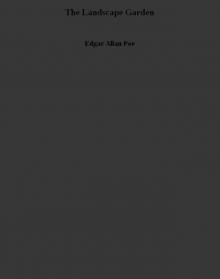 The Landscape Garden
The Landscape Garden Complete Tales & Poems
Complete Tales & Poems Great Tales and Poems of Edgar Allan Poe
Great Tales and Poems of Edgar Allan Poe The Colloquy of Monos and Una
The Colloquy of Monos and Una The Oblong Box
The Oblong Box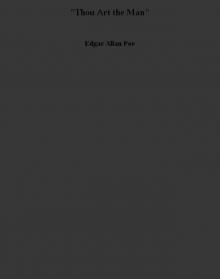 Thou Art the Man
Thou Art the Man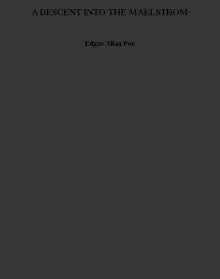 A DESCENT INTO THE MAELSTROM
A DESCENT INTO THE MAELSTROM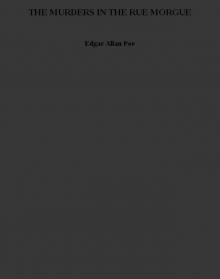 THE MURDERS IN THE RUE MORGUE
THE MURDERS IN THE RUE MORGUE The Business Man
The Business Man The Mystery of Marie Rogêt
The Mystery of Marie Rogêt Metzengerstein
Metzengerstein The Man That Was Used Up
The Man That Was Used Up William Wilson
William Wilson The Philosophy of Composition
The Philosophy of Composition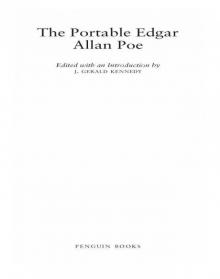 The Portable Edgar Allan Poe
The Portable Edgar Allan Poe Bon-Bon
Bon-Bon A Predicament
A Predicament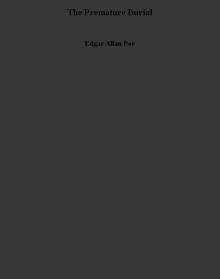 The Premature Burial
The Premature Burial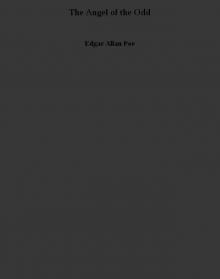 The Angel of the Odd
The Angel of the Odd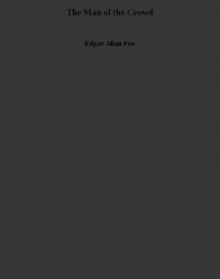 The Man of the Crowd
The Man of the Crowd Never Bet the Devil Your Head
Never Bet the Devil Your Head The Tell-Tale Heart and Other Writings
The Tell-Tale Heart and Other Writings The System of Doctor Tarr and Professor Fether
The System of Doctor Tarr and Professor Fether Selected Tales (Oxford World's Classics)
Selected Tales (Oxford World's Classics) Essential Tales and Poems of Edgar Allan Poe (Barnes & Noble Classics Series)
Essential Tales and Poems of Edgar Allan Poe (Barnes & Noble Classics Series) MS. Found in a Bottle
MS. Found in a Bottle Some Words with a Mummy
Some Words with a Mummy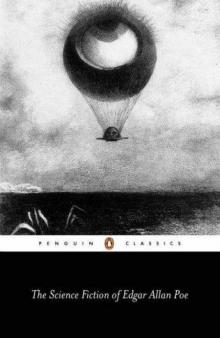 The Science Fiction of Edgar Allan Poe (Penguin Classics)
The Science Fiction of Edgar Allan Poe (Penguin Classics) King Pest
King Pest CRITICISM
CRITICISM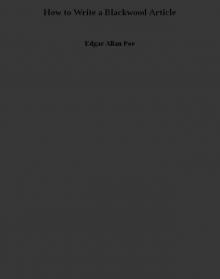 How to Write a Blackwood Article
How to Write a Blackwood Article Mystification
Mystification Diddling Considered as One of the Exact Sciences
Diddling Considered as One of the Exact Sciences Steampunk Poe
Steampunk Poe The Literary Life of Thingum Bob, Esq.
The Literary Life of Thingum Bob, Esq. Classic Crime Collection
Classic Crime Collection Complete Stories and Poems of Edgar Allen Poe
Complete Stories and Poems of Edgar Allen Poe Berenice
Berenice The Black Cat
The Black Cat The Slender Poe Anthology
The Slender Poe Anthology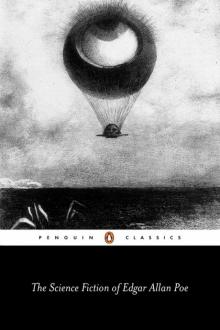 The Science Fiction of Edgar Allan Poe
The Science Fiction of Edgar Allan Poe The Assignation
The Assignation The Thousand-and-Second Tale of Scheherazade
The Thousand-and-Second Tale of Scheherazade The Raven and Other Short Stories
The Raven and Other Short Stories The Spectacles
The Spectacles Hop-Frog
Hop-Frog The Purloined Letter
The Purloined Letter Mellonta Tauta
Mellonta Tauta The Balloon-Hoax
The Balloon-Hoax Landor's Cottage
Landor's Cottage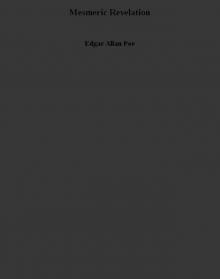 Mesmeric Revelation
Mesmeric Revelation The Pit and the Pendulum
The Pit and the Pendulum